
文/石哲宇 陳雪|Article/Shi Zheyu Chen Xue
蘇州吳江旭輝吳門(mén)府書(shū)院
Suzhou Wujiang Xuhui Wumenfu Academy
蘇州吳江旭輝社區(qū)中心位于蘇州市吳江區(qū)南部,是一片新興的生態(tài)城市片區(qū) 。設(shè)計(jì)力圖為周邊居住組團(tuán)注入活力 ,活躍人群并凝聚社區(qū)精神 。在著手這個(gè)位于蘇州的項(xiàng)目之初 ,宋照青先生為整個(gè)建筑與景觀的設(shè)計(jì)定下了基調(diào):通過(guò)一個(gè)實(shí)在而輕巧之物懸于景觀之上,在幾處庭院之間限定出一個(gè)無(wú)邊的空間。項(xiàng)目幾經(jīng)推敲之后,最終實(shí)現(xiàn)的成果可概括為一亭 、一橋、三院及一池淺水 ,引申下去則有更多重的探索在其中:
Suzhou Wujiang Xuhui Community Center is located in the southern part of Wujiang District , Suzhou City and is a new ecological city area. The design strives to invigorate the surrounding residential groups, revitalize the community and agglomerate the spirit of the community. At the beginning of this project in Suzhou, Mr. Song Zhaoqing set the tone for the design of the entire building and landscape: through a real and lightweight object suspended above the landscape, a boundless space is defined between several courtyards. After several scrutiny of the project, the final achievement could be summed up as a kiosk, a bridge, a three-housing and a shallow pool of water. There will be more important explorations in the future:
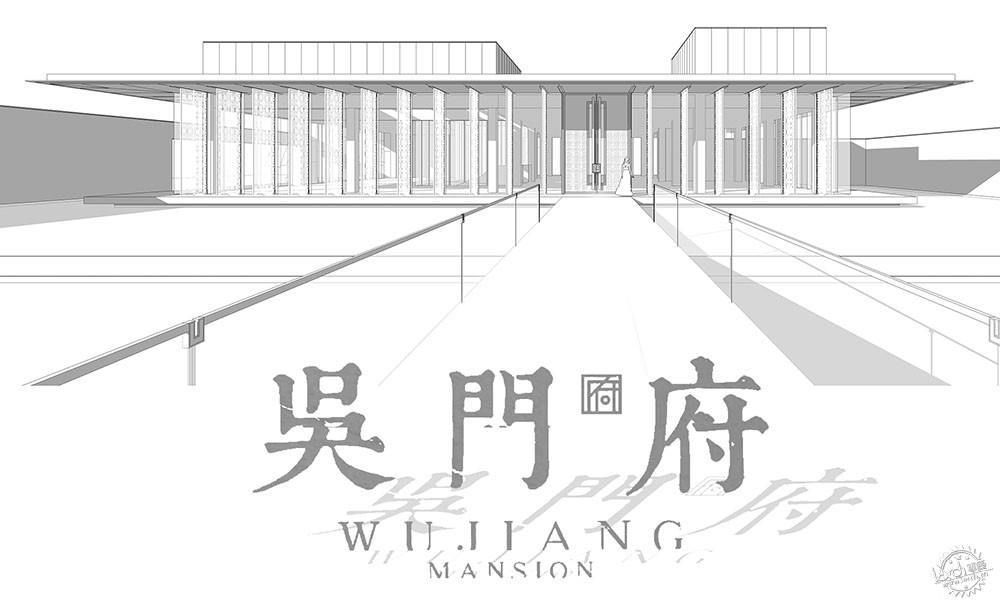 項(xiàng)目簡(jiǎn)介
蘇州吳江旭輝社區(qū)中心位于蘇州市吳江區(qū)南部
項(xiàng)目簡(jiǎn)介
蘇州吳江旭輝社區(qū)中心位于蘇州市吳江區(qū)南部 ,距離吳江區(qū)中心10公里,是一片新興的生態(tài)城市片區(qū) 。設(shè)計(jì)力圖為周邊居住組團(tuán)注入活力 ,活躍人群并凝聚社區(qū)精神。建筑沿鱸鄉(xiāng)南路這一城市主干道布置 ,綠色生態(tài)廊道置于其中 ,讓城市綠地資源接入地塊 ,擴(kuò)展了綠地邊界 ,并激活了這一優(yōu)越的城市資源 。
Program Introduction
Suzhou Wujiang Xuhui Community Center is located in the southern part of Wujiang District , Suzhou City and is 10 kilometers away from the center of Wujiang District. It is a new ecological city area. The design strives to invigorate the surrounding residential groups, revitalize the community and agglomerate the spirit of the community. The building is located along the main road of the township, Luxiang South Road. A green ecological corridor is placed in it, allowing the urban green space resource to access the land, expanding the boundary of the green space and activating this superior urban resource.
 吳門(mén)府書(shū)院總平面/The general plane of Wumenfu Academy
1. 屋與園的意向重組
由建筑空間圍合而成的庭院是千百年來(lái)中國(guó)傳統(tǒng)建筑的重要空間構(gòu)成
吳門(mén)府書(shū)院總平面/The general plane of Wumenfu Academy
1. 屋與園的意向重組
由建筑空間圍合而成的庭院是千百年來(lái)中國(guó)傳統(tǒng)建筑的重要空間構(gòu)成,培養(yǎng)傳承了一代又一代中國(guó)人的居住習(xí)慣和審美情趣 。本次設(shè)計(jì)中也嘗試進(jìn)一步深入挖掘隱匿在建筑形式背后的人文精神的同時(shí)讓建筑使用符合時(shí)代的需求。
Reorganisation of the house and garden
The courtyard enclosed by the building space is an important space composition of Chinese traditional architecture for thousands of years. It has inherited the living habits and aesthetic tastes of generation after generation of Chinese people. In this design, we also tried to dig deeper into the humanistic spirit behind the architectural forms while allowing the use of the building to meet the needs of the time.
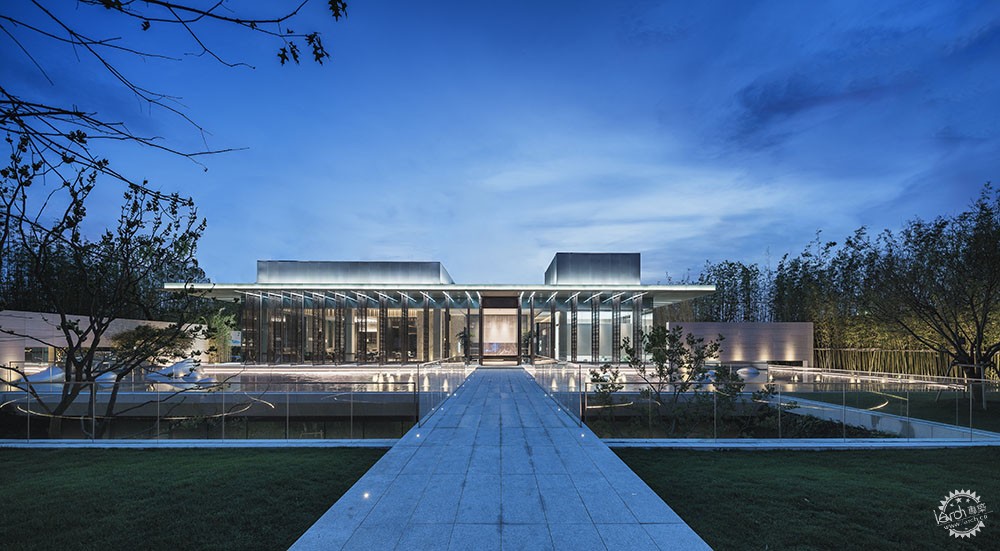 一亭
一亭、一橋及一池淺水/A kiosk, a bridge, a three-housing and a shallow pool of water
每一個(gè)蘇州的園林都是一個(gè)微觀的世界,在這些園林中,“建筑”本身并未占太多的比重 。我們并不能理解為建筑在園林中不重要 ,而是園林之美本就在于建筑與景觀的滲透與重組,建筑即景觀 ,景觀也是建筑設(shè)計(jì)的重要組成部分 。
Every Suzhou garden is a microscopic world. In these gardens, "architecture" itself does not account for too much proportion. We cannot understand that the architecture is not important in gardens, but the beauty of gardens lies in the penetration and reorganization of architecture and landscapes. The architecture is the landscape that is also the important constituent part of architecture design.
 書(shū)院主立面透視/The main facade of the academy
旭輝書(shū)院作為這一住區(qū)未來(lái)的主要入口,是居民的視線聚焦之處,起到銜接城市空間,統(tǒng)領(lǐng)片區(qū)風(fēng)貌精髓的整合作用。設(shè)計(jì)中用“像素化”的手法將中式大屋頂抽象為了一片連綿舒展的挑檐與三個(gè)起伏的體塊,每個(gè)體塊在功能與尺度上都有所不同,或?yàn)樘齑啊⒒驗(yàn)檗k公所用的二層閣樓。一方面滿足了形態(tài)上的多樣性,契合和園林中亭臺(tái)樓閣的交相呼應(yīng)之景,也滿足了對(duì)屋檐之下不同空間使用方式的暗示。屋檐之下
書(shū)院主立面透視/The main facade of the academy
旭輝書(shū)院作為這一住區(qū)未來(lái)的主要入口,是居民的視線聚焦之處,起到銜接城市空間,統(tǒng)領(lǐng)片區(qū)風(fēng)貌精髓的整合作用。設(shè)計(jì)中用“像素化”的手法將中式大屋頂抽象為了一片連綿舒展的挑檐與三個(gè)起伏的體塊,每個(gè)體塊在功能與尺度上都有所不同,或?yàn)樘齑啊⒒驗(yàn)檗k公所用的二層閣樓。一方面滿足了形態(tài)上的多樣性,契合和園林中亭臺(tái)樓閣的交相呼應(yīng)之景,也滿足了對(duì)屋檐之下不同空間使用方式的暗示。屋檐之下 ,四面通透,毫無(wú)遮蔽的將四周景觀納入建筑內(nèi)部 ,體現(xiàn)了中正對(duì)稱和現(xiàn)代極簡(jiǎn)的審美統(tǒng)一 。
Xuhui academy of classical learning as the main entrance in the future of the settlement, is citizens’ focal point. It has the integration effect of connecting to urban space and commanding the the essence of the area. The design uses a “pixelation” approach to abstract the large Chinese roof as a continuous stretch of provocation and three undulating masses. Each mass is different in function and scale, either as a sunroof, or two-floor loft for office use. Under the eaves, it is surrounded by a transparent and unobstructed view that incorporates the surrounding landscape into the interior of the building, embodying the aesthetic unity of symmetry and modern minimalism.
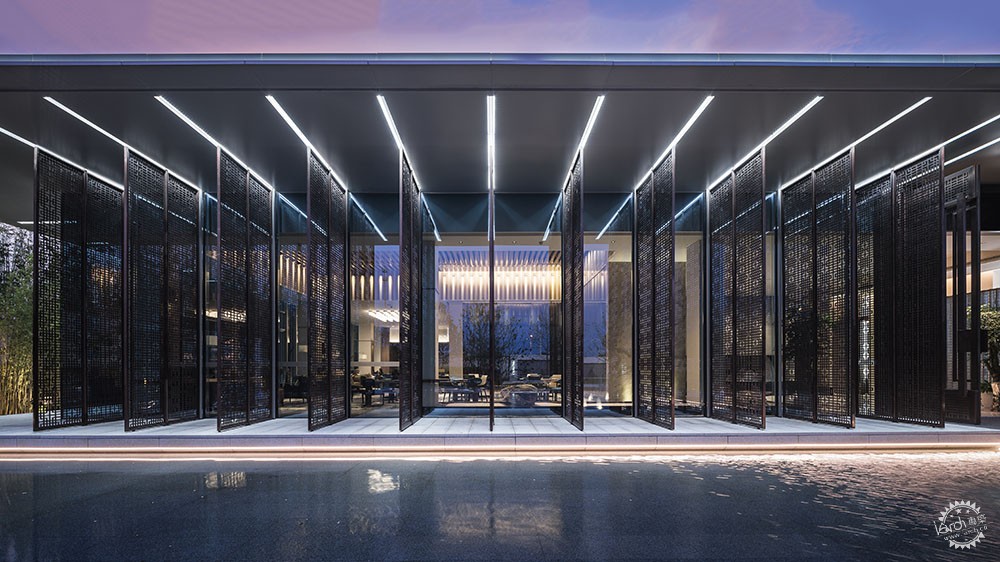 吳門(mén)府書(shū)院主入口/Wumenfu academy main entrance
2. 多層次庭院的疊合與空間的流動(dòng)
在現(xiàn)代的建筑設(shè)計(jì)中,有這樣一個(gè)趨勢(shì)
吳門(mén)府書(shū)院主入口/Wumenfu academy main entrance
2. 多層次庭院的疊合與空間的流動(dòng)
在現(xiàn)代的建筑設(shè)計(jì)中,有這樣一個(gè)趨勢(shì) ,隨著城市變遷的節(jié)奏普遍加快 ,怎樣讓壽命幾十年甚至數(shù)百年的建筑在敏感市場(chǎng)的調(diào)控下以不變的姿態(tài)迎接千變?nèi)f化種使用功能的要求?這一問(wèn)題即便是在設(shè)計(jì)之初就已經(jīng)顯現(xiàn)了 。在一個(gè)較短的時(shí)間內(nèi) ,這一建筑將經(jīng)歷展示與銷(xiāo)售、社區(qū)服務(wù)以及健身會(huì)所等多重功能需求 ,單是幾個(gè)階段的功能平面研究 ,在設(shè)計(jì)初期就研究了數(shù)十稿之多。
The overlapping of multi-level courtyard and the flow of space
In the modern architecture design, there is such a trend. As the rhythm of urban change generally accelerates, how can buildings with decades of life or even hundreds of years to meet the requirements of the ever-changing species' use functions be maintained in a constant posture under the control of sensitive markets? This problem has already emerged even at the beginning of design. In a short period of time, the building will experience multiple functional needs such as display and sales, community services, and fitness clubs. The study of functional planes in several periods was just a matter of several dozens of drafts in the early stages of design.
 一層平面圖/First floor plan
一層平面圖/First floor plan
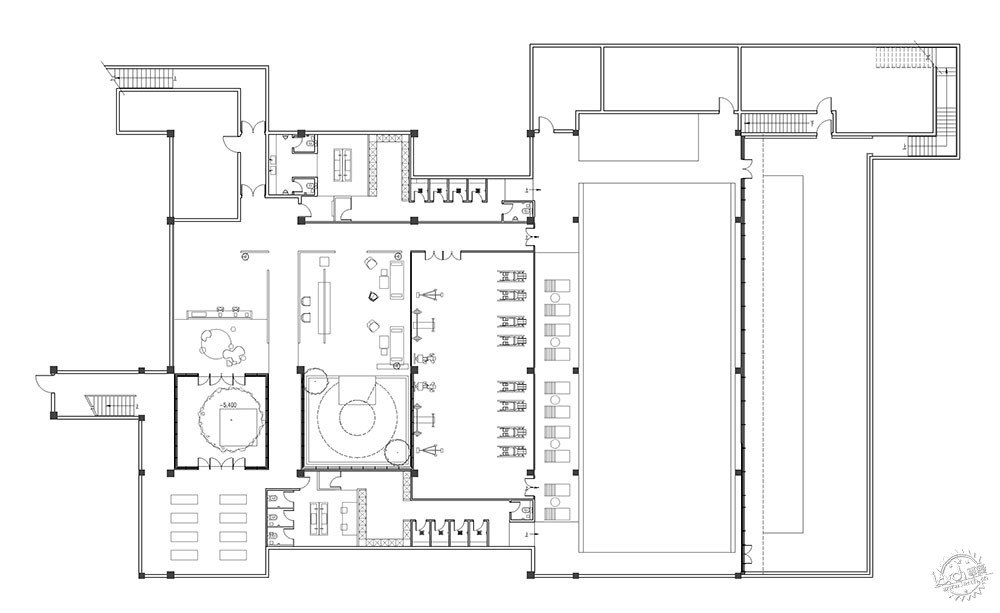 地下一層平面圖/Basement floor plan
地下一層平面圖/Basement floor plan
 剖面一/Section One
剖面一/Section One
 剖面二/Section Two
我們的策略是在看似平整統(tǒng)一的立面之后
剖面二/Section Two
我們的策略是在看似平整統(tǒng)一的立面之后 ,通過(guò)塑造一個(gè)有流動(dòng)性的平面空間 ,點(diǎn)綴以不同尺度的庭院 ,打造不同的空間圍合,承載個(gè)人休憩和公共活動(dòng)功能 ,體驗(yàn)親切包容的人文關(guān)懷態(tài)度 。這一做法與當(dāng)代多位建筑家的實(shí)踐作品有共通之處。例如屈米在拉維萊特公園中以點(diǎn)陣坐標(biāo)的形式在無(wú)序空間中植入?yún)⒄拯c(diǎn) ,為各個(gè)空間賦予獨(dú)特性格 ;再例如石上純也的神奈川科技學(xué)院活動(dòng)中心,在消隱的立面后 ,數(shù)百顆細(xì)柱疏密有致的排列在流動(dòng)的平面上 ,組合出各式不同的院落空間、不同程度的獨(dú)立而又彼此聯(lián)系 。這以類似的手法起到了讓空間之間進(jìn)一步弱化封閉感 ,加強(qiáng)了功能流動(dòng)與序列引導(dǎo)作用,將前庭 、中院 、后堂等傳統(tǒng)空間錯(cuò)落于其中。
After the facade that looks flat and uniform, through creating a liquid flat space, our strategy is to embellish yards of different scales,create different space enclosure, carry individual rest and public function and experience a kind and inclusive humanistic care attitude. This behavior has something in common with many contemporary architects' practical works. For example, in the form of lattice coordinates, Tschumi laid a reference point in a chaotic space in the La villette Park ,giving each space a unique character; then, Junya ISHIGAMI’s Kanagawa Science Academy Activity Center, behind the blanking facade, hundreds of thin columns were densely arranged on the plane of the flow, combining various courtyard spaces of different types, and being independent and connected to each other in varying degrees. This similar skill has helped to further weaken the sense of closure between the space, strengthened the functional flow and the role of sequence guidance, and put traditional space such as the antecourt, the middle courtyard, and the backyard into the place.
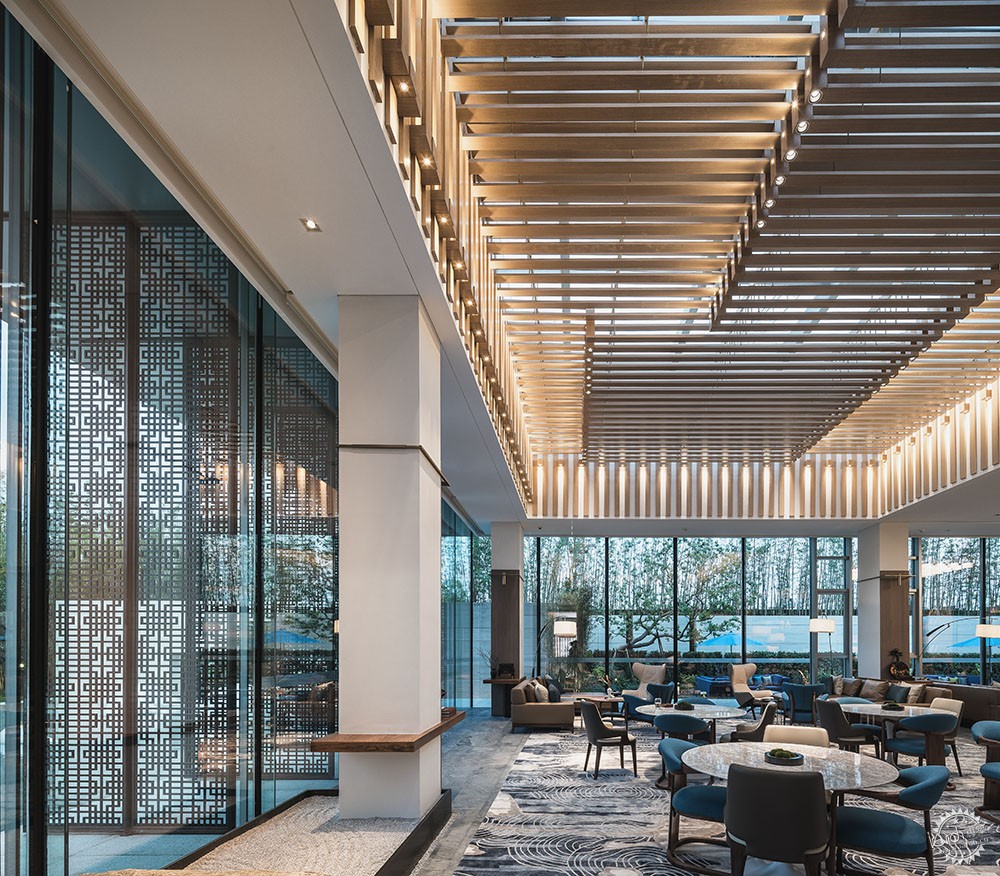 書(shū)院內(nèi)景/The academy's interior
書(shū)院內(nèi)景/The academy's interior
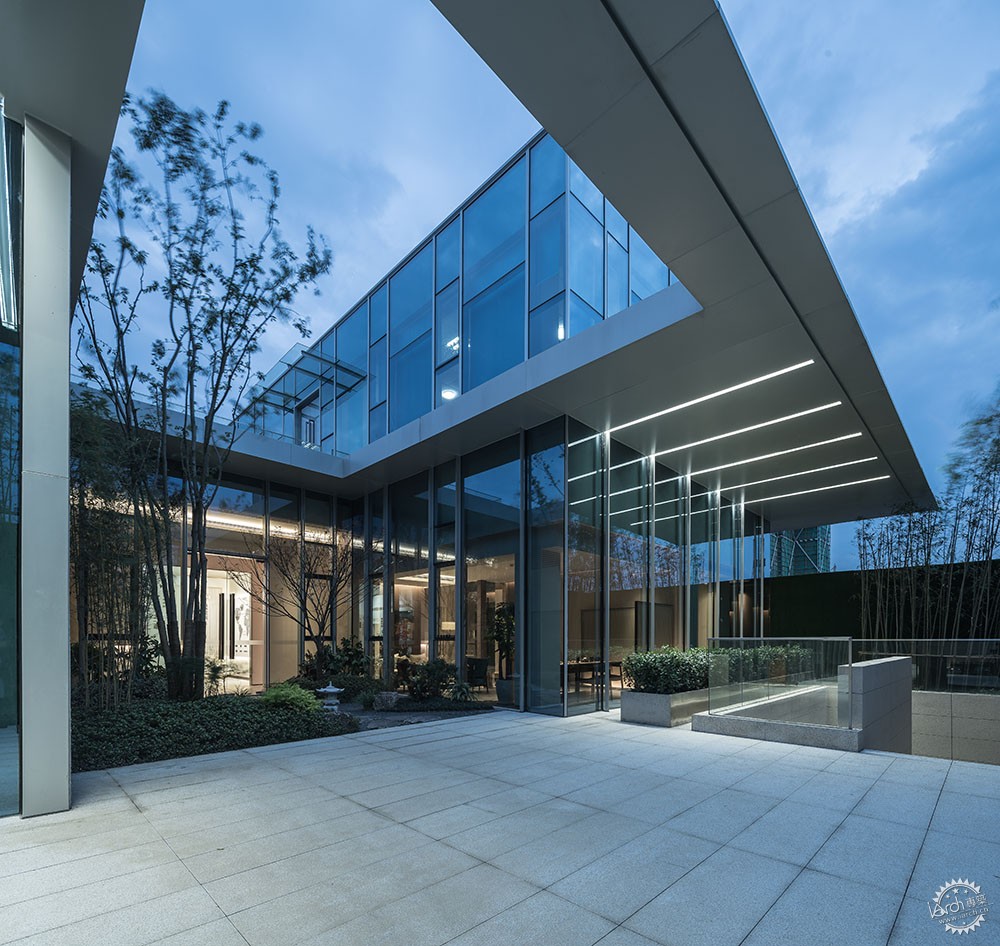 書(shū)院北院/The academy north courtyard
書(shū)院北院/The academy north courtyard
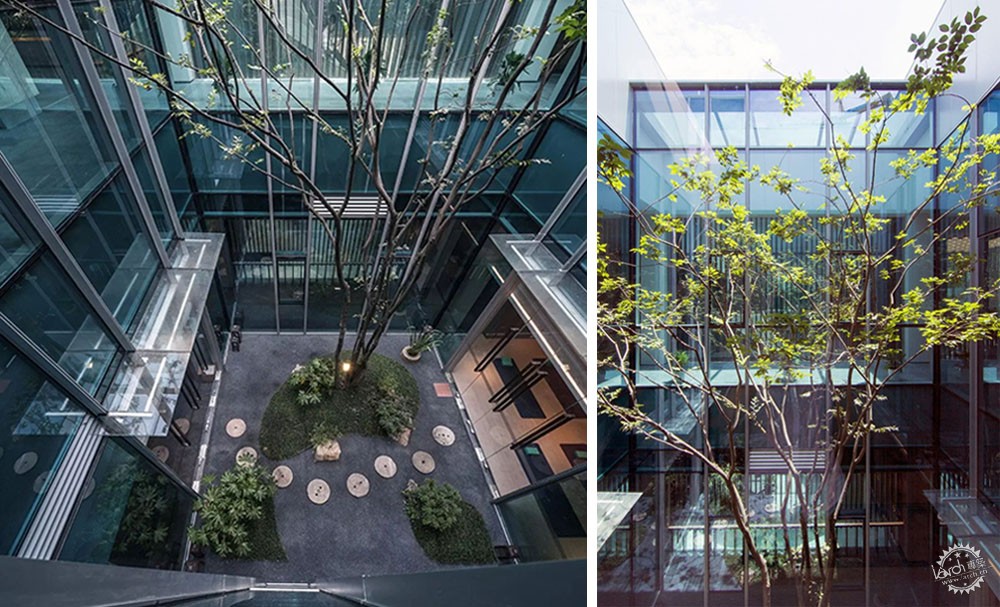 書(shū)院中院/The Academy’s middle courtyard and
書(shū)院中院/The Academy’s middle courtyard and
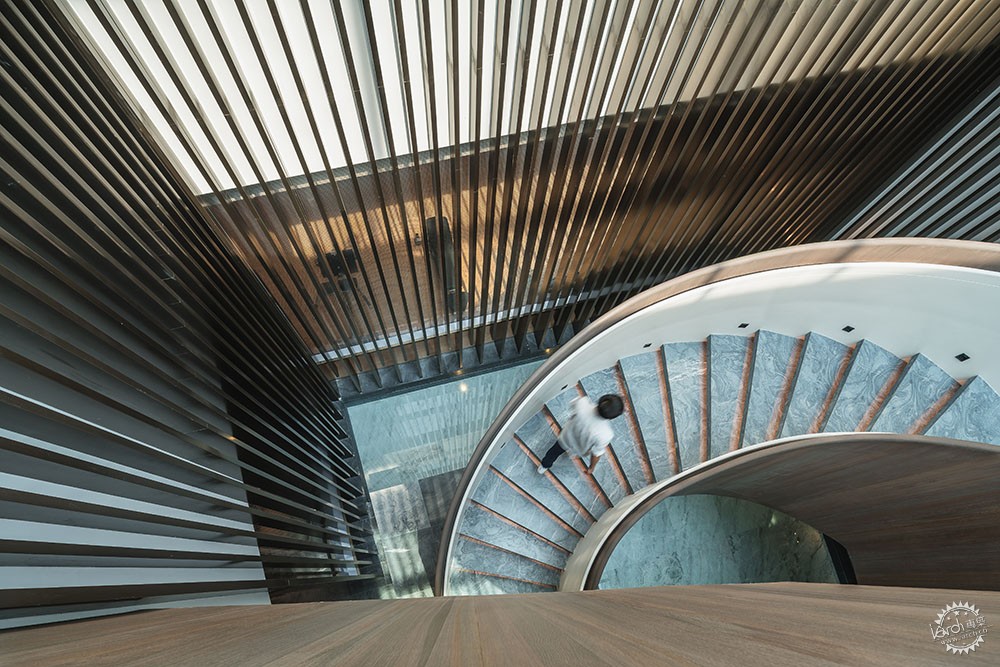
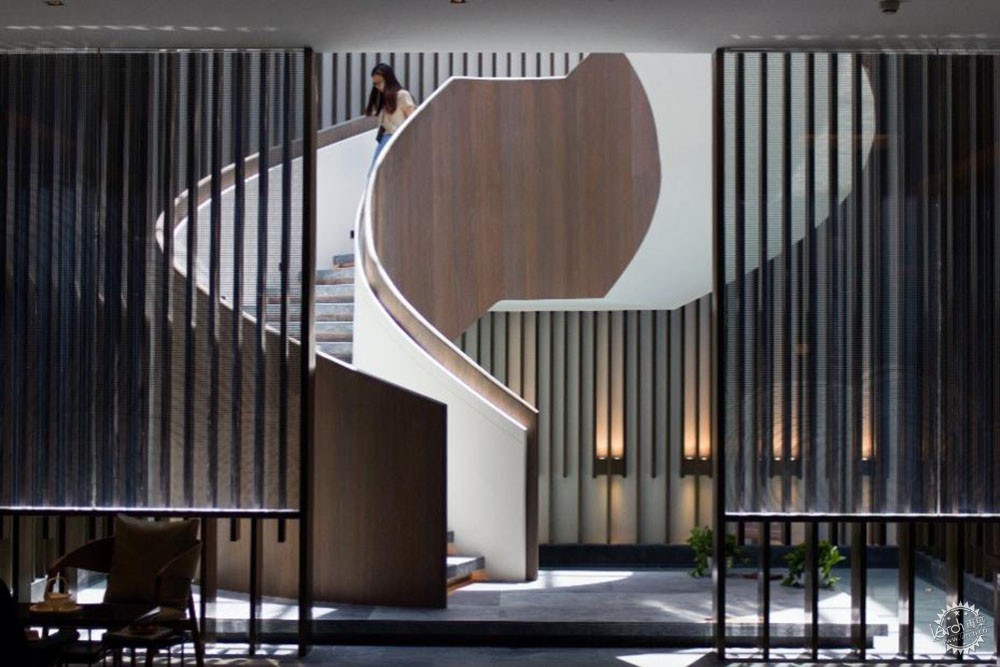 連接地下會(huì)所的旋轉(zhuǎn)樓梯/spiral stair connected to the underground chamber
此營(yíng)造方式讓室內(nèi)的空間序列依舊呈現(xiàn)院落般的遞進(jìn)與起承轉(zhuǎn)合。同時(shí)也讓景觀傍水造園,相互映襯,力求內(nèi)外空間互通互融。這樣讓室內(nèi)外層層院落的疊合與聯(lián)通藏風(fēng)聚氣,亭臺(tái)樓閣、水榭連橋等各個(gè)元素一起,在城市主界面上反映出了公共空間到私密空間的完整轉(zhuǎn)換。
This construction method makes the indoor space sequence still present courtyard-like progression and turnaround. At the same time, it also makes the landscape waterfront garden, set off each other,and strive to achieve mutual interaction between the internal and external space.In this way, the superposition of indoor and outdoor layers of courtyards and the integration of various elements such as pavilions and bridges are reflected in the main interface of the city, reflecting the complete conversion of public space to private space.
連接地下會(huì)所的旋轉(zhuǎn)樓梯/spiral stair connected to the underground chamber
此營(yíng)造方式讓室內(nèi)的空間序列依舊呈現(xiàn)院落般的遞進(jìn)與起承轉(zhuǎn)合。同時(shí)也讓景觀傍水造園,相互映襯,力求內(nèi)外空間互通互融。這樣讓室內(nèi)外層層院落的疊合與聯(lián)通藏風(fēng)聚氣,亭臺(tái)樓閣、水榭連橋等各個(gè)元素一起,在城市主界面上反映出了公共空間到私密空間的完整轉(zhuǎn)換。
This construction method makes the indoor space sequence still present courtyard-like progression and turnaround. At the same time, it also makes the landscape waterfront garden, set off each other,and strive to achieve mutual interaction between the internal and external space.In this way, the superposition of indoor and outdoor layers of courtyards and the integration of various elements such as pavilions and bridges are reflected in the main interface of the city, reflecting the complete conversion of public space to private space.
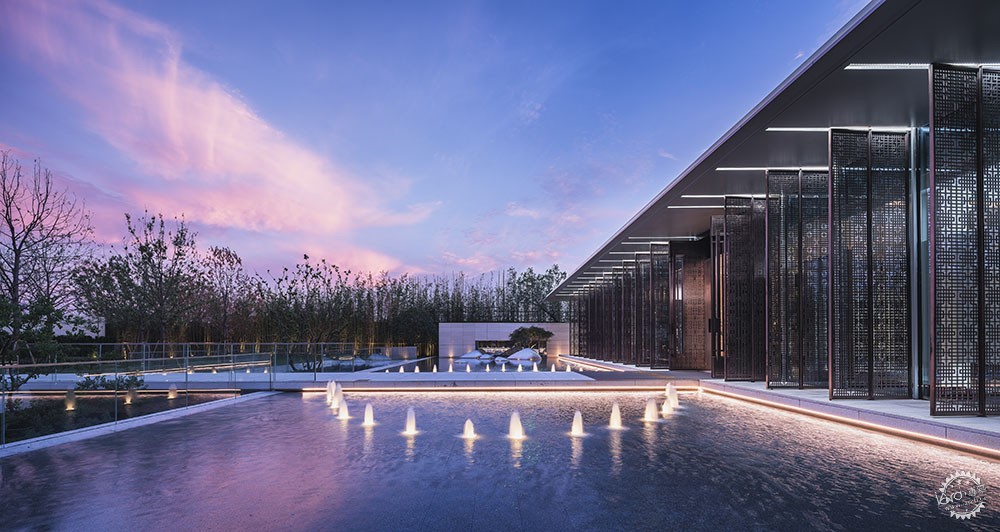 書(shū)院入口空間/Academy’s entrance space
書(shū)院入口空間/Academy’s entrance space
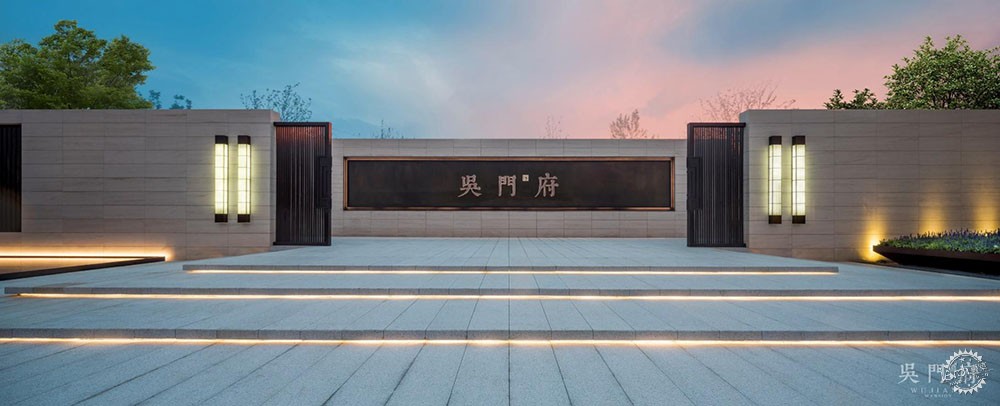 前院入口提示/Front entrance tips
3. 建筑景觀一體化設(shè)計(jì)手法營(yíng)造多維度的空間滲透
很長(zhǎng)一段時(shí)間,建筑和景觀都是作為相對(duì)獨(dú)立的,甚至是互相割裂的二個(gè)元素存在著,使用不同的語(yǔ)言邏輯,表達(dá)各自的哲學(xué)。旭輝吳江項(xiàng)目,日清力求在同一場(chǎng)所中取得建筑與景觀的平衡和相互滲透。
Integrated architectural design method to create multidimensional space infiltration
For a long time, buildings and landscapes were relatively independent and even separated from each other. They used different language logic to express their respective philosophy. Xuhui Wujiang project, Riqing strives to achieve balance and mutual penetration of architecture and landscape in the same place.
前院入口提示/Front entrance tips
3. 建筑景觀一體化設(shè)計(jì)手法營(yíng)造多維度的空間滲透
很長(zhǎng)一段時(shí)間,建筑和景觀都是作為相對(duì)獨(dú)立的,甚至是互相割裂的二個(gè)元素存在著,使用不同的語(yǔ)言邏輯,表達(dá)各自的哲學(xué)。旭輝吳江項(xiàng)目,日清力求在同一場(chǎng)所中取得建筑與景觀的平衡和相互滲透。
Integrated architectural design method to create multidimensional space infiltration
For a long time, buildings and landscapes were relatively independent and even separated from each other. They used different language logic to express their respective philosophy. Xuhui Wujiang project, Riqing strives to achieve balance and mutual penetration of architecture and landscape in the same place.
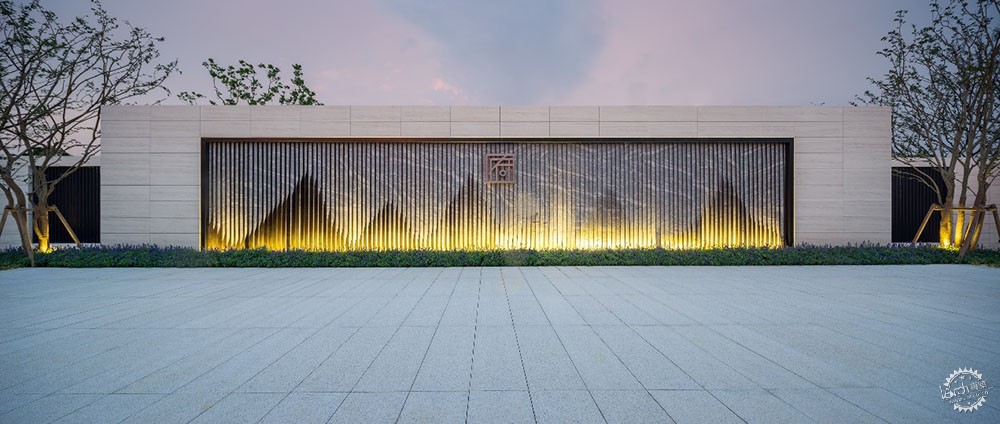 前院照壁/The front yard on the wall
前院照壁/The front yard on the wall
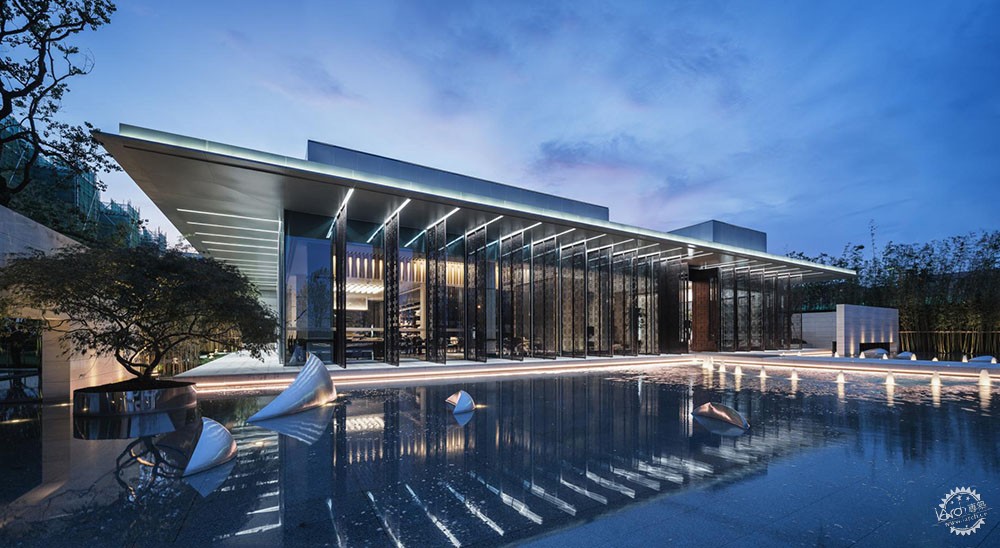
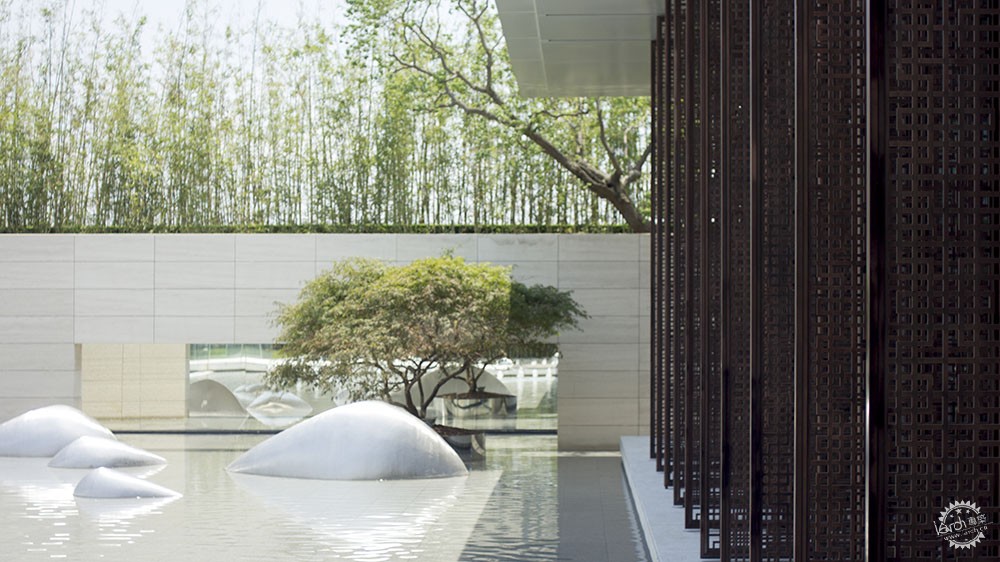
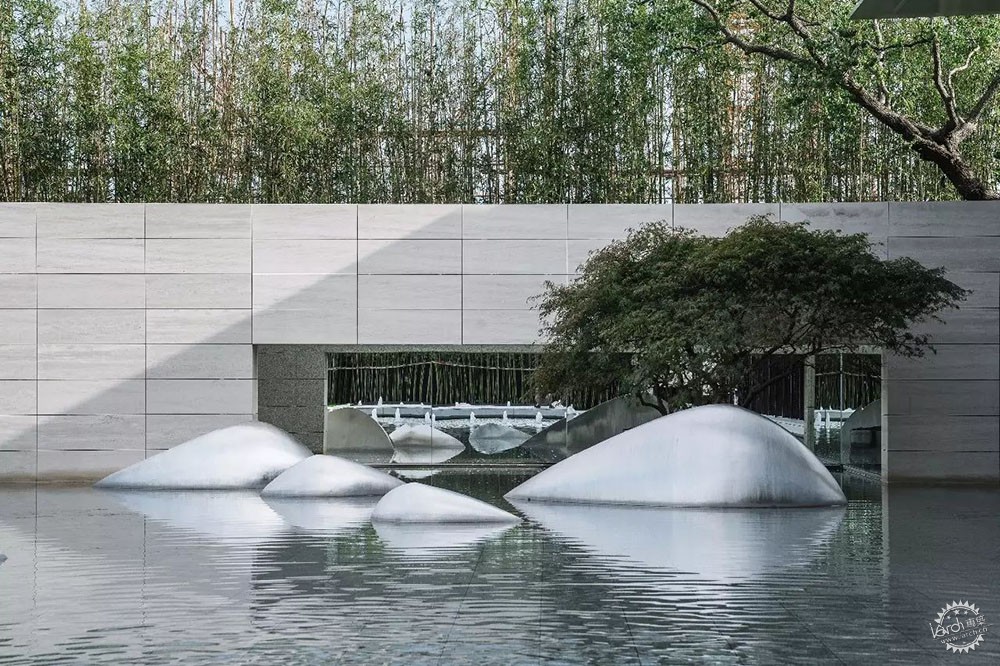 建筑與景觀交織共生/Architecture and landscape intertwined.
建筑與景觀需要在設(shè)計(jì)意圖上達(dá)成統(tǒng)一。密斯凡德羅的觀點(diǎn),建筑最佳的處理方法就是盡量以平淡如水的敘事口吻直接切入到建筑的本質(zhì),形成既分割又連通,既簡(jiǎn)單又復(fù)雜的空間序列;室內(nèi)室外也互相穿插貫通,沒(méi)有截然分界,呈現(xiàn)奇妙的建筑景觀“無(wú)界”狀態(tài)。項(xiàng)目中,透過(guò)似有若無(wú)的建筑玻璃幕墻,我們可以看到“越丘陵、過(guò)雙橋、渡山水”后,悠然“撫琴、聞香、品茶”等層層遞進(jìn)的景致關(guān)系。不僅僅是自然景物自遠(yuǎn)至近、大觀盡而現(xiàn)小雅的變化。
The architecture and the landscape need to achieve unity in design intent. From the point of view of Mies van der Rohe, the best way to deal with architecture is to cut into the essence of the building with a plain, watery narrative tone, and to form a spatial sequence that is both segmented and connected, simple and complex; indoors and outdoors are also interspersed with each other, and there is no clear distinction between them, presenting a wonderful architectural landscape “unbounded”. In the project, through the seemingly devoid of architectural glass curtain walls, we can see the progressively scenic relationships of "crossing the hills, crossing TwinBridge , and crossing the mountains," later, enjoying the " playing the musical instrument, smelling fragrance, and tasting the tea". It is not only the change of the natural scenery from the far to the near and as small as it can be.
建筑與景觀交織共生/Architecture and landscape intertwined.
建筑與景觀需要在設(shè)計(jì)意圖上達(dá)成統(tǒng)一。密斯凡德羅的觀點(diǎn),建筑最佳的處理方法就是盡量以平淡如水的敘事口吻直接切入到建筑的本質(zhì),形成既分割又連通,既簡(jiǎn)單又復(fù)雜的空間序列;室內(nèi)室外也互相穿插貫通,沒(méi)有截然分界,呈現(xiàn)奇妙的建筑景觀“無(wú)界”狀態(tài)。項(xiàng)目中,透過(guò)似有若無(wú)的建筑玻璃幕墻,我們可以看到“越丘陵、過(guò)雙橋、渡山水”后,悠然“撫琴、聞香、品茶”等層層遞進(jìn)的景致關(guān)系。不僅僅是自然景物自遠(yuǎn)至近、大觀盡而現(xiàn)小雅的變化。
The architecture and the landscape need to achieve unity in design intent. From the point of view of Mies van der Rohe, the best way to deal with architecture is to cut into the essence of the building with a plain, watery narrative tone, and to form a spatial sequence that is both segmented and connected, simple and complex; indoors and outdoors are also interspersed with each other, and there is no clear distinction between them, presenting a wonderful architectural landscape “unbounded”. In the project, through the seemingly devoid of architectural glass curtain walls, we can see the progressively scenic relationships of "crossing the hills, crossing TwinBridge , and crossing the mountains," later, enjoying the " playing the musical instrument, smelling fragrance, and tasting the tea". It is not only the change of the natural scenery from the far to the near and as small as it can be.
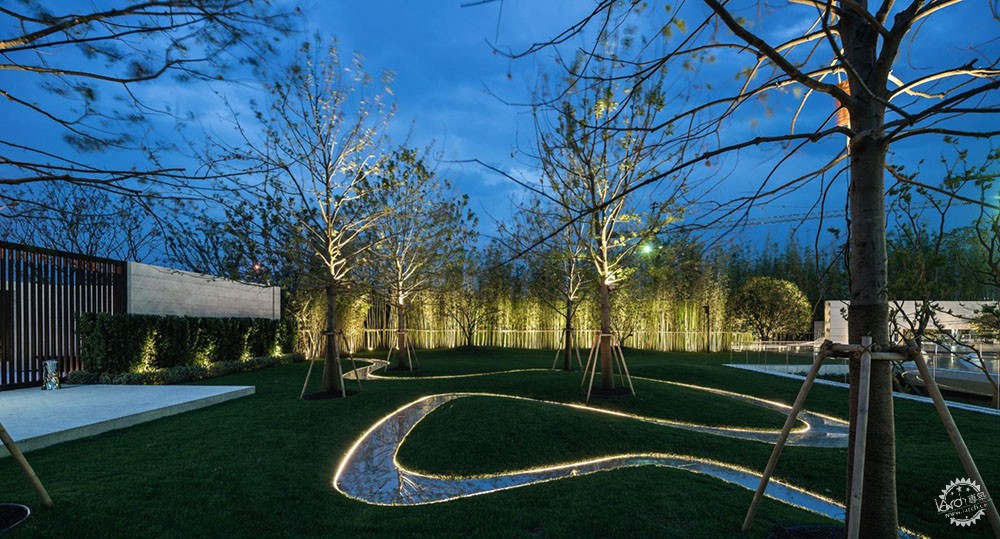 前院主景觀/Forecourt’s main landscape
前院主景觀/Forecourt’s main landscape
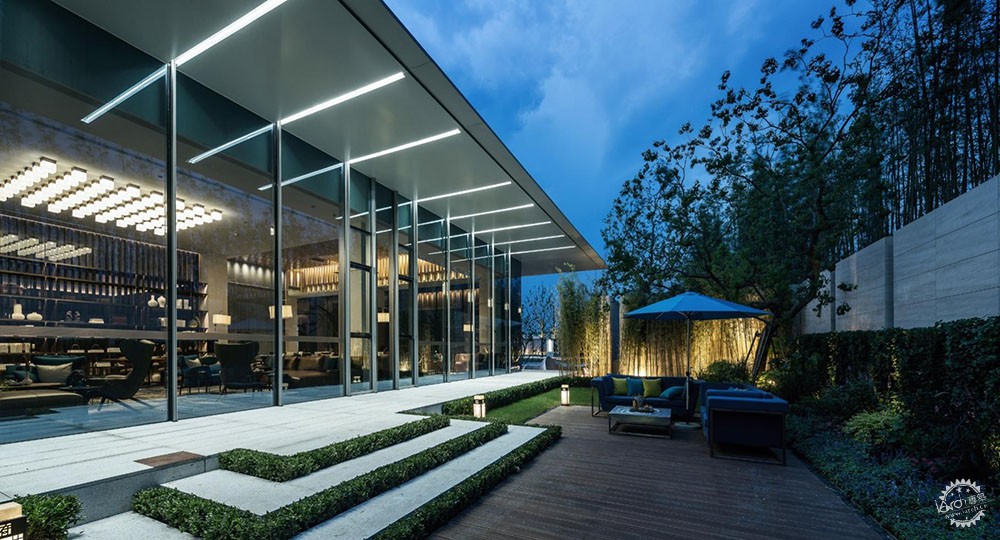 書(shū)院南院景觀/Academy south courtyard landscape.
書(shū)院南院景觀/Academy south courtyard landscape.


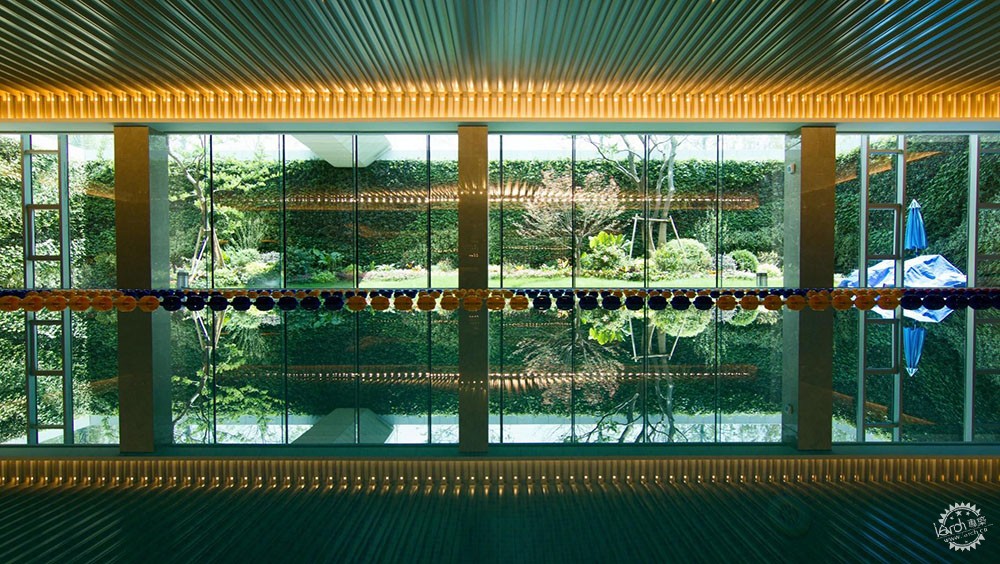
 泳池及下沉庭院/The swimming pool and the sinking courtyard
建筑中的景觀與景觀中的建筑。用植物造景的風(fēng)景意向拓展建筑內(nèi)部的景觀空間。中庭,自負(fù)一層而起且無(wú)頂部遮蓋,光線便很好地穿透下來(lái),通過(guò)玻璃幕墻把禪意的植物景致反射,再反射,像匯聚于鉆石之上的光暈般將景觀往建筑的四面八方層層疊疊擴(kuò)展開(kāi)來(lái)。地下室內(nèi)泳池,玻璃幕墻之外的下沉庭院中,三面垂直綠墻,通過(guò)不同色彩、葉型的植株布局出山水浮云的自然形態(tài),令使用者感受到被景觀包裹的建筑場(chǎng)所私密與安全。
Buildings in the landscape and the landscape in the buildings. The landscape intention of planting scenery expands the landscape space inside the building. In the atrium, from the negative one-storey , no top cover, the light penetrates well. Through the glass curtain wall, the view of the zen plant is reflected and reflected again, like the halo that gathers on the diamond, spreading the landscape to the buildings in all directions. Underground indoor swimming pool, in the sinking courtyard outside the glass curtain wall, three vertical green walls, through the arrangement of different colours and leaf-shaped plants, the natural form of the landscape floating cloud makes the user feel the privacy and security of the construction site surrounded by the landscape.
泳池及下沉庭院/The swimming pool and the sinking courtyard
建筑中的景觀與景觀中的建筑。用植物造景的風(fēng)景意向拓展建筑內(nèi)部的景觀空間。中庭,自負(fù)一層而起且無(wú)頂部遮蓋,光線便很好地穿透下來(lái),通過(guò)玻璃幕墻把禪意的植物景致反射,再反射,像匯聚于鉆石之上的光暈般將景觀往建筑的四面八方層層疊疊擴(kuò)展開(kāi)來(lái)。地下室內(nèi)泳池,玻璃幕墻之外的下沉庭院中,三面垂直綠墻,通過(guò)不同色彩、葉型的植株布局出山水浮云的自然形態(tài),令使用者感受到被景觀包裹的建筑場(chǎng)所私密與安全。
Buildings in the landscape and the landscape in the buildings. The landscape intention of planting scenery expands the landscape space inside the building. In the atrium, from the negative one-storey , no top cover, the light penetrates well. Through the glass curtain wall, the view of the zen plant is reflected and reflected again, like the halo that gathers on the diamond, spreading the landscape to the buildings in all directions. Underground indoor swimming pool, in the sinking courtyard outside the glass curtain wall, three vertical green walls, through the arrangement of different colours and leaf-shaped plants, the natural form of the landscape floating cloud makes the user feel the privacy and security of the construction site surrounded by the landscape.
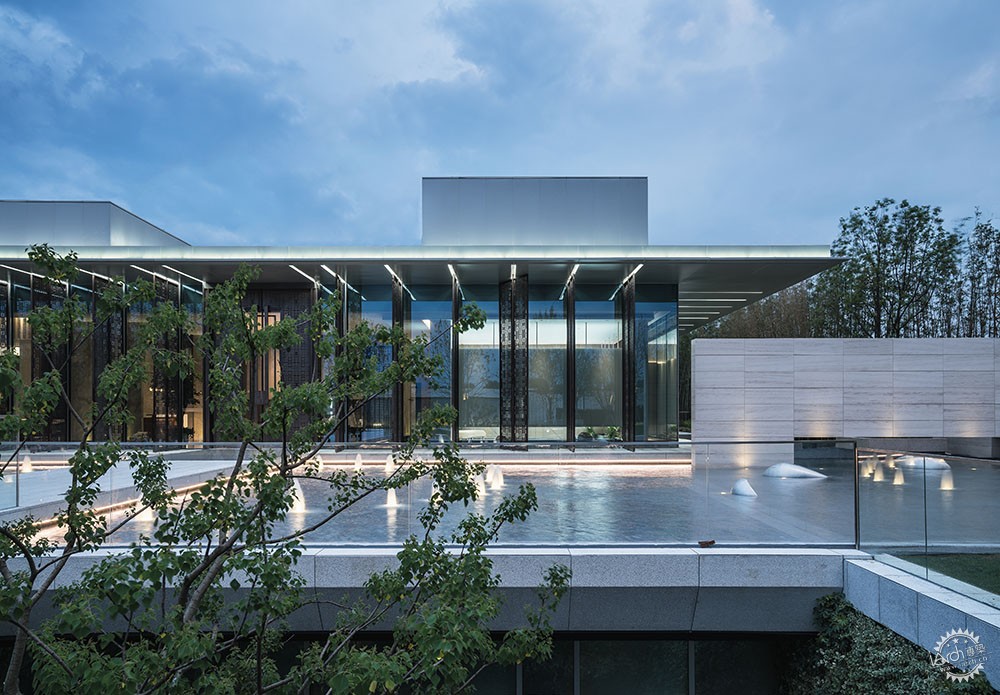 庭院、水景與建筑層層呼應(yīng)/Courtyard, water scene and building layer echoing
庭院、水景與建筑層層呼應(yīng)/Courtyard, water scene and building layer echoing
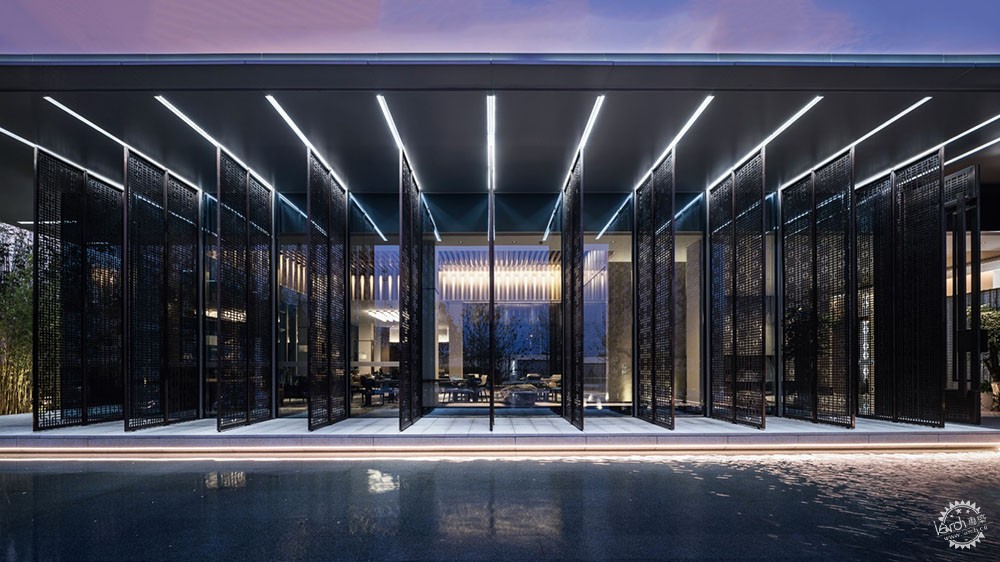 書(shū)院立面局部/Part of the facade of the academy
4. 現(xiàn)代精致構(gòu)造設(shè)計(jì)營(yíng)造現(xiàn)代中式意境
營(yíng)造中式建筑不應(yīng)是簡(jiǎn)單的符號(hào)模仿,現(xiàn)代建筑也不僅僅是玻璃幕墻與金屬面板的堆砌,而是要突出建筑深層次的文化內(nèi)涵和歷史底蘊(yùn),體現(xiàn)對(duì)傳統(tǒng)符號(hào)所指代的精神的傳承,對(duì)傳統(tǒng)空間發(fā)展變化的詮釋。建筑師Colin Rowe與Robert Slutzky在其共同的著作“透明性”一書(shū)中表達(dá)了對(duì)格羅皮烏斯的建筑手法的不滿,認(rèn)為在包豪斯學(xué)校建筑上大量運(yùn)用的玻璃幕墻是毫無(wú)意義的,因?yàn)橥高^(guò)幕墻只能看到玻璃后復(fù)雜的金屬鉸鏈和建筑結(jié)構(gòu)。他們的理論認(rèn)為格羅皮烏斯的手法只是表達(dá)了玻璃材料的“材料性”透明屬性,并沒(méi)有強(qiáng)調(diào)玻璃作為墻面的“現(xiàn)象性”屬性。也就是玻璃幕墻可以為建筑提供一種水平與縱向的延伸感,也可以為觀者的提供視覺(jué)上的一種感覺(jué),即幾層空間與事物的活動(dòng)透過(guò)玻璃相互滲透卻不彼此破壞。本項(xiàng)目的立面與平面設(shè)計(jì)為實(shí)踐這一建筑手法提供了可能性
書(shū)院立面局部/Part of the facade of the academy
4. 現(xiàn)代精致構(gòu)造設(shè)計(jì)營(yíng)造現(xiàn)代中式意境
營(yíng)造中式建筑不應(yīng)是簡(jiǎn)單的符號(hào)模仿,現(xiàn)代建筑也不僅僅是玻璃幕墻與金屬面板的堆砌,而是要突出建筑深層次的文化內(nèi)涵和歷史底蘊(yùn),體現(xiàn)對(duì)傳統(tǒng)符號(hào)所指代的精神的傳承,對(duì)傳統(tǒng)空間發(fā)展變化的詮釋。建筑師Colin Rowe與Robert Slutzky在其共同的著作“透明性”一書(shū)中表達(dá)了對(duì)格羅皮烏斯的建筑手法的不滿,認(rèn)為在包豪斯學(xué)校建筑上大量運(yùn)用的玻璃幕墻是毫無(wú)意義的,因?yàn)橥高^(guò)幕墻只能看到玻璃后復(fù)雜的金屬鉸鏈和建筑結(jié)構(gòu)。他們的理論認(rèn)為格羅皮烏斯的手法只是表達(dá)了玻璃材料的“材料性”透明屬性,并沒(méi)有強(qiáng)調(diào)玻璃作為墻面的“現(xiàn)象性”屬性。也就是玻璃幕墻可以為建筑提供一種水平與縱向的延伸感,也可以為觀者的提供視覺(jué)上的一種感覺(jué),即幾層空間與事物的活動(dòng)透過(guò)玻璃相互滲透卻不彼此破壞。本項(xiàng)目的立面與平面設(shè)計(jì)為實(shí)踐這一建筑手法提供了可能性,為玻璃墻面提供一種張力 ,達(dá)到透明性的“現(xiàn)象”屬性。
Modern exquisite structural design creating modern Chinese artistic conception
The construction of Chinese-style buildings should not be a simple symbolic imitation. Modern architecture is not only the building of glass curtain walls and metal panels, but also highlights the deep cultural connotations and historical connotations of the buildings and reflects the inheritance of the spirits represented by traditional symbols. , the interpretation of the development and changes of traditional space. Architects Colin Rowe and Robert Slutzky expressed their dissatisfaction with Gropius's architectural approach in his book "Transparency" and believe that the extensive use of glass walls in Bauhaus school buildings is meaningless. Because through the curtain wall you could only see the complex metal hinge and building structure behind the glass. Their theory held that Gropius's method only expressed the "material" transparency of glass materials, and did not emphasize glass as a "phenomenon" property of walls.In other words, the glass curtain wall can provide a horizontal and vertical extension of the building, and it can also provide the viewer with a visual sense that several layers of space and the activities of things penetrate through the glass without destroying each other. The fa?ade and graphic design of this project provide the possibility to practice this architectural approach, providing a tension to the glass wall and achieving the “phenomenon” property of transparency.
 可開(kāi)閉屏風(fēng)/Open-and-close screen’s
可開(kāi)閉屏風(fēng)/Open-and-close screen’s
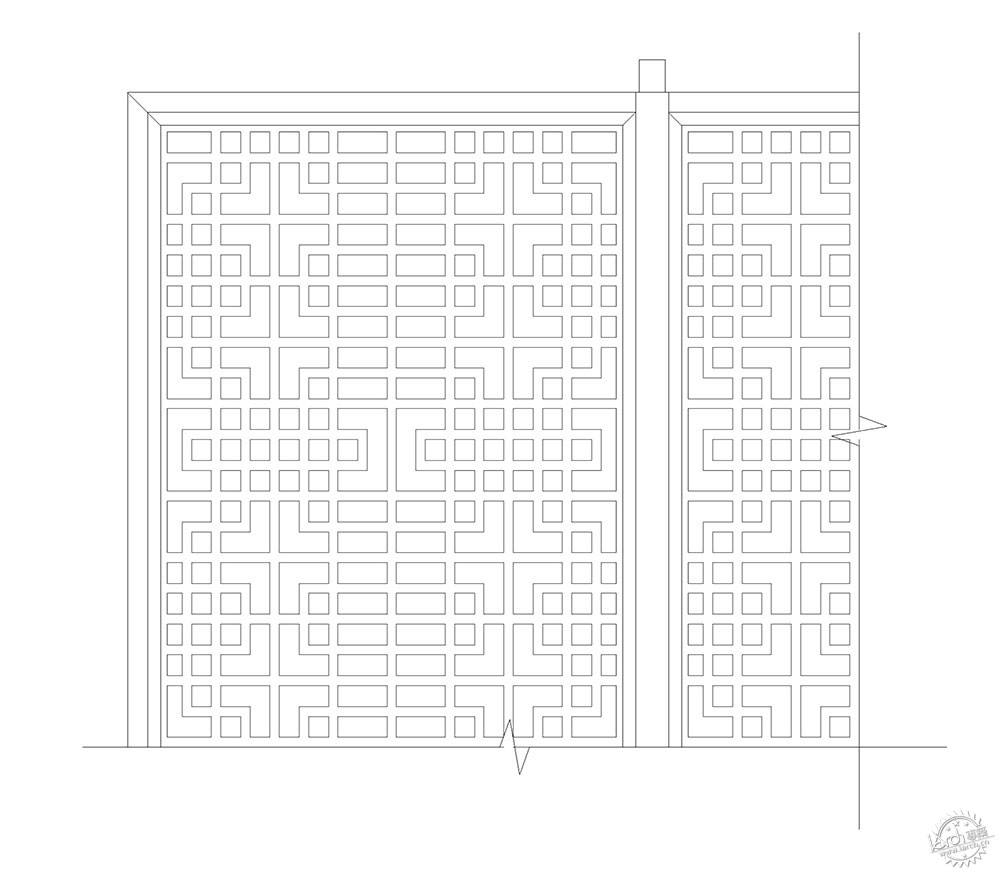 屏風(fēng)紋樣大樣(局部)/dermatoglyphic pattern bulk sample(Part)
為了完整實(shí)現(xiàn)這一初衷
屏風(fēng)紋樣大樣(局部)/dermatoglyphic pattern bulk sample(Part)
為了完整實(shí)現(xiàn)這一初衷,玻璃幕墻本身的設(shè)計(jì)需要盡可能的干凈與輕巧 ,盡可能的刪除不必要的結(jié)構(gòu),讓玻璃幕墻完全消隱于室內(nèi)與室外空間之間 。因此采用了櫥窗式玻璃肋玻璃幕墻形式 ,并在轉(zhuǎn)角處通過(guò)上下入槽的構(gòu)造方式達(dá)到了轉(zhuǎn)角無(wú)柱的空間效果,進(jìn)一步消隱了結(jié)構(gòu)感 。為了加強(qiáng)室內(nèi)外滲透的效果 ,懸挑的鋁板屋檐下設(shè)置了與玻璃面垂直陣列的凹形燈槽,利用反光原理營(yíng)造了屋頂?shù)膬?nèi)外聯(lián)通的效果 。除此之外 ,還在玻璃幕墻外設(shè)置了建筑的第二層表皮,即一系列可旋轉(zhuǎn)開(kāi)閉的屏風(fēng) 。這一設(shè)置在不僅在視覺(jué)上增強(qiáng)了建筑立面的進(jìn)深感 ,也進(jìn)一步削弱了玻璃分縫帶來(lái)的視覺(jué)阻礙。不僅在這面向東面的主立面上 ,由早晨的陽(yáng)光透過(guò)它投出豐富多樣的光影 ,也在建筑節(jié)能與文化屬性上提升了建筑品質(zhì)。
In order to fully realize this original intention, the design of the glass curtain wall itself needs to be as clean and light as possible, remove unnecessary structures as much as possible, and make the glass curtain wall be completely hidden between the indoor and outdoor space. Therefore, a window-type glass ribbed glass curtain wall form was adopted, and a space effect without pillars was achieved through the structure of the upper and lower slots at the corners, further eliminating the structural sense. In order to enhance the effect of indoor and outdoor infiltration, a concave lamp trough with a vertical array of glass surfaces was set under the eaves of the cantilevered aluminum plate, and the effect of internal and external communication of the roof was created by using the principle of light reflection. In addition, the second skin of the building was set outside the glass curtain wall, that was, a series of screens that could be opened and closed. This setup not only visually enhanced the deep feeling of building facades, but also further weakened the visual obstruction from glass joints. Not only on this main east-facing facade, the morning sunlight through it threw a variety of light and shadow, but also enhanced the architectural quality of building energy conservation and cultural attributes.
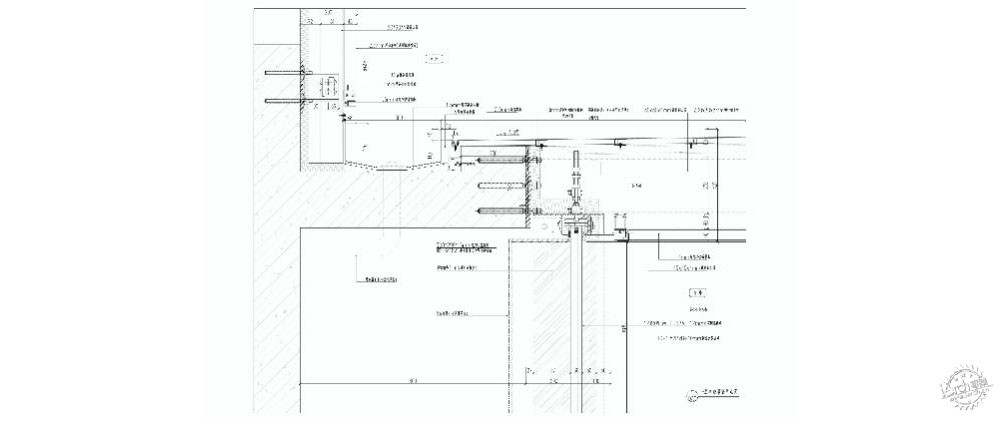 幕墻及挑檐細(xì)部節(jié)點(diǎn)(根部)/The curtain wall and the curtain wall of the cornice detail node (root)
幕墻及挑檐細(xì)部節(jié)點(diǎn)(根部)/The curtain wall and the curtain wall of the cornice detail node (root)
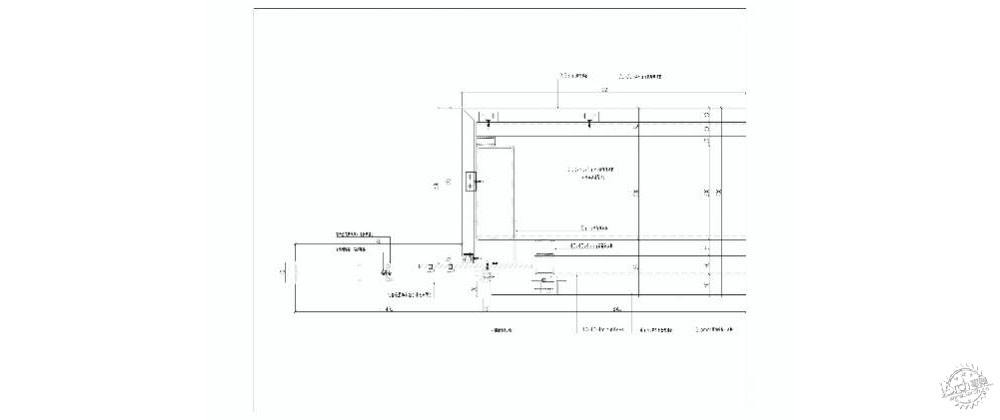 幕墻及挑檐細(xì)部節(jié)點(diǎn)(端部)/the curtain wall of the cornice detail node (end)
同時(shí),極簡(jiǎn)的建筑語(yǔ)匯離不開(kāi)細(xì)致的節(jié)點(diǎn)控制。建筑涵蓋了一系列復(fù)雜的節(jié)點(diǎn)設(shè)計(jì)讓建筑在復(fù)雜的氣候條件下輕松應(yīng)對(duì)。由于建筑有四米的挑檐,為了保證挑檐端部的纖細(xì)尺寸,在設(shè)計(jì)之初就有屋面自由排水的想法,但是很快就被否定了。為了保證有組織排水向內(nèi)找坡,挑檐被的結(jié)構(gòu)被設(shè)計(jì)為兩段,由混凝土柱伸出的第一段為混凝土挑板,兼顧天溝的作用,再由挑板伸出鋼結(jié)構(gòu)挑梁,最終實(shí)現(xiàn)了有組織排水的同時(shí)達(dá)到了最初的造型設(shè)計(jì)要求。類似的細(xì)節(jié)處理還有很多
幕墻及挑檐細(xì)部節(jié)點(diǎn)(端部)/the curtain wall of the cornice detail node (end)
同時(shí),極簡(jiǎn)的建筑語(yǔ)匯離不開(kāi)細(xì)致的節(jié)點(diǎn)控制。建筑涵蓋了一系列復(fù)雜的節(jié)點(diǎn)設(shè)計(jì)讓建筑在復(fù)雜的氣候條件下輕松應(yīng)對(duì)。由于建筑有四米的挑檐,為了保證挑檐端部的纖細(xì)尺寸,在設(shè)計(jì)之初就有屋面自由排水的想法,但是很快就被否定了。為了保證有組織排水向內(nèi)找坡,挑檐被的結(jié)構(gòu)被設(shè)計(jì)為兩段,由混凝土柱伸出的第一段為混凝土挑板,兼顧天溝的作用,再由挑板伸出鋼結(jié)構(gòu)挑梁,最終實(shí)現(xiàn)了有組織排水的同時(shí)達(dá)到了最初的造型設(shè)計(jì)要求。類似的細(xì)節(jié)處理還有很多,他們一起讓建筑可以再風(fēng)雨中同樣保持著寧?kù)o與沉穩(wěn)。
At the same time, minimalist architectural vocabulary can not be separated from detailed node control. The building covers a series of complex joint designs that make it easy for the building to respond to complex climate conditions. Because of the four-metre cornice of the building, in order to ensure the slim size of the cornice ’s end, the idea of free drainage of the roof at the beginning of the design was quickly denied. In order to ensure that the organized drainage is inwardly sloped, the cornice structure is designed into two sections. The first section out of the concrete column is the concrete picking board, taking into account the role of the gutter. Then picking the plate out of the steel structure cantilever beam, and finally achieve organized drainage while meeting the initial design requirements. There are many similar details to deal with, and they make the building stay calm and peaceful again in the wind and rain.
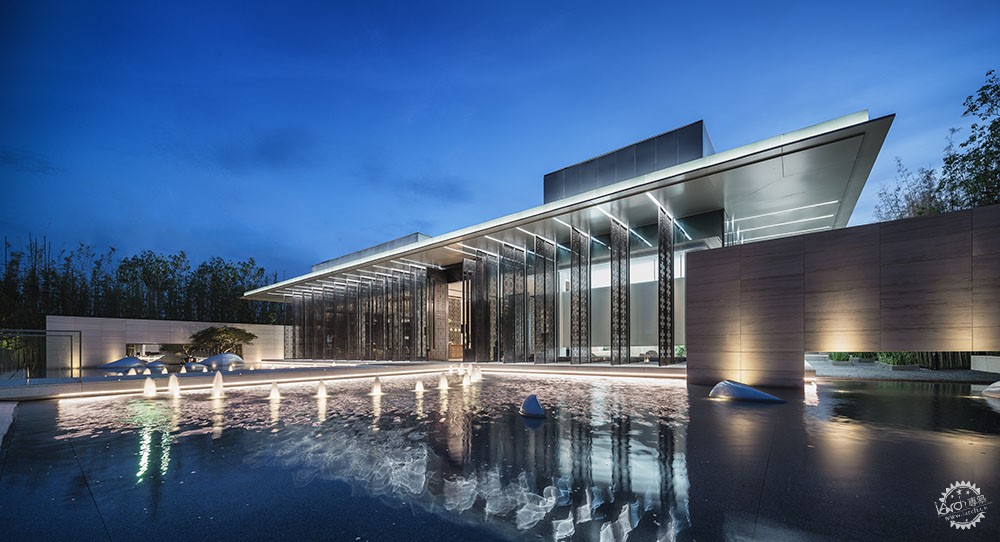 結(jié)語(yǔ)
最終形成的建筑立面不僅是一個(gè)建筑形態(tài)的表達(dá)
結(jié)語(yǔ)
最終形成的建筑立面不僅是一個(gè)建筑形態(tài)的表達(dá),更是建筑與景觀園林的一體化表達(dá) 。在這其中剛勁簡(jiǎn)練的建筑本體 、抽象精簡(jiǎn)的中式屏風(fēng)、室外景物小品 、室內(nèi)光影 、以及參與室內(nèi)外活動(dòng)的訪客,共同在建筑立面之間構(gòu)成了一副被壓縮的淺景深畫(huà)作 。這景致是吳江旭輝社區(qū)書(shū)院所有從設(shè)計(jì)到落成參與的各專業(yè)同仁的智慧結(jié)晶 ,他也將記載蘇州人現(xiàn)代生活與園林情節(jié)的時(shí)空對(duì)話,成為吳江人生活的縮影 。
Epilogue
The final building facade is not only an expression of an architectural form, but also an integrated expression of architecture and landscape. Among them, the concise architectural body, abstractly-reduced Chinese screens, outdoor scenery pieces, indoor lighting, and visitors participating in indoor and outdoor activities together form a compressed shallow depth of field painting between the building facades.This scenery is the wisdom of all professional colleagues of Wujiang Xuhui Community Academy from the design to completion. It will also record the space-time dialogue between the modern life and garden plots of the people in Suzhou and become the epitome of people's life in Wu Jiang.
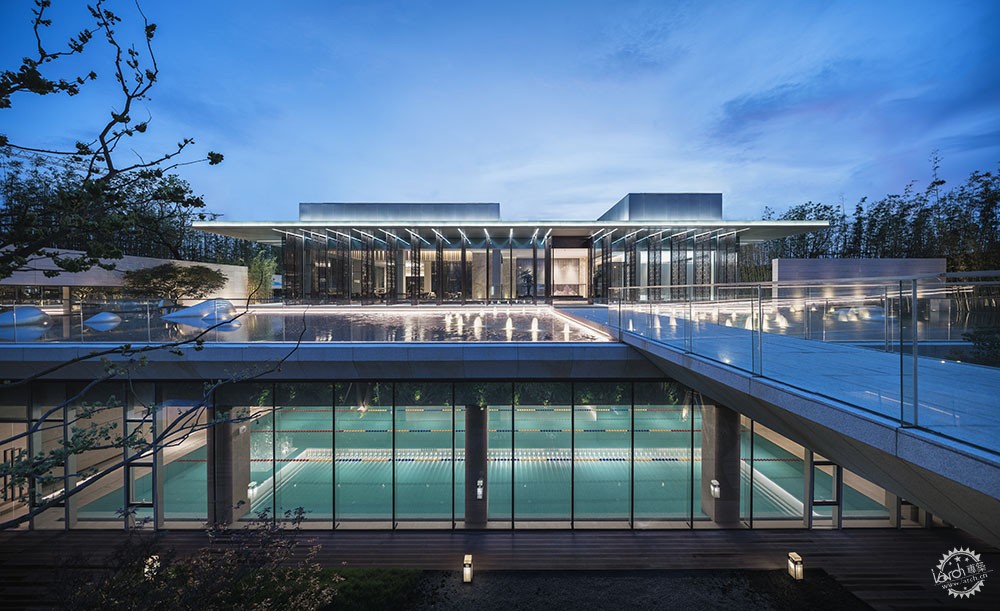
|